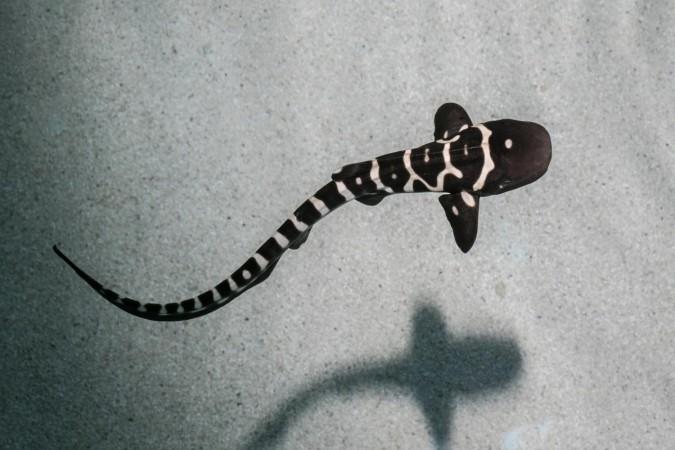The iconic line from Jurrasic Park, "Life finds a way," is forever etched in popular culture—thanks to Jeff Goldbloom's inimitable delivery. Like a prophecy expeditiously fulfilling itself, some of the dinosaurs from the park's entirely female population are found to lay eggs in the movie. However, in a fascinating real-life contradiction, scientists have discovered a case of 'virgin birth' in a female zebra shark at a US aquarium despite the availability of mature reproductive males in the same enclosure.
In a new study, a multi-institutional team of researchers have reported the birth of zebra shark (Stegostoma tigrinum) pups through parthenogenesis, a form of asexual reproduction. The occurrence was recorded at Shedd Aquarium, an indoor public aquarium in Chicago, Illinois. According to the authors, this is one of the only documented instances of female sharks reproducing parthenogenetically in spite of healthy sexually mature males being present in their habitat.
"We've known for several years that parthenogenesis occurs in animals like sharks, but some aspects of it remain unknown, like why it occurs and what triggers it. This latest paper is just another step in learning why these 'virgin births' happen," said Dr. Kevin Feldhim, corresponding author of the study, in a statement. The findings—which can inform breeding and conservation efforts—were published in the Journal of Fish Biology.
No Men Please!

Parthenogenesis literally means 'virgin birth' (Greek: Parthenos means 'virgin' and genesis means ' birth' or 'creation' or 'origin'). It is a type of asexual reproduction that takes place when a female gamete or egg develops into offspring without being fertilized by the male gamete or sperm. Several species of invertebrates such as roundworms, ants, bees, and scorpions, among others, are known to reproduce in this manner.
While rare in vertebrates, certain species of amphibians, birds, snakes, and lizards, are also reproduce parthenogenetically. Scientists posit that vertebrates usually resort to this form of procreation only in the absence—or if there is a shortage—of mature males for females to mate with. For example, the New Mexico whiptail (Aspidoscelis neomexicanus), an all-female species of lizard, reproduces through parthenogenesis exclusively.
Parthenogenetic reproduction has been recorded among zebra sharks as well. In fact, they are among the handfuls of shark species such as the Blacktip shark (Carcharhinus limbatus) and the Bonnethead (Sphyrna tiburo) that are known to reproduce via parthenogenesis.
Determining Parentage of Baby Sharks

Shedd Aquarium has run a successful breeding programme for zebra sharks since 2004, with over 100 pups hatching at the facility after the inception of the initiative. As a part of the programme, genetic testing is conducted regularly to confirm the parentage of the baby sharks.
"By confirming the lineage of the offspring, we could more soundly make decisions on future breeding efforts to maintain maximum genetic diversity while supporting the Association of Zoos and Aquarium's Species Survival Plan for zebra sharks," explained Dr. Lise Watson, co-author of the study.
The zebra shark population at the aquarium is held in the 'Wild Reef', a massive floor-to-ceiling habitat housing several species of sharks such as the Sandbar and Blacktip Reef sharks, and other marine life. In 2008, Dr. Watson observed a clutch of zebra shark eggs in the enclosure and moved them to a nursery. Following their hatching, the tiny sharks were subjected to DNA analysis in order to ascertain their parentage.
Born Without a Father

Little did the researchers expect that their regular examination would yield not-so-regular findings: while the DNA of the pups matched with the female—known as "Bubbles"—that laid the eggs, it did not match with any of the mature males in the habitat. The team also found that in addition to the absence of genetic markers from a father, the pups possessed identical homozygous copies of specific alleles.
An allele is a variation of a gene. It is found at the same location on a particular chromosome as the original gene and regulates similar functions. When an offspring inherits the same allele from both parents, it is called homozygous. Unlike human beings, zebra sharks possess several alleles, to the point where it is nearly impossible for them to appear precisely in the same fashion in two separate individuals.
In the case of the studied zebra shark pups, the alleles were acquired from their mother alone. This confirmed that the birth of the pups was indeed a 'virgin birth'. "Discovering these pups were parthenotes was quite a surprise for the team at Shedd, given our previous success in encouraging breeding through sexual reproduction. This news underscored exactly why regular, ongoing genetic testing of offspring is important," noted Dr. Watson.
Informing Breeding and Conservation Efforts

As mentioned above, parthenogenetic reproduction is not unheard of among zebra sharks. Unfortunately, the life expectancy of shark pups born this way is often short–the pups from the study survived only for a few months. However, despite their short life, the birth of the shark pups has managed to challenge long-held ideas about parthenogenesis.
"This is only the second case that we know of where sharks have been born by parthenogenesis even when there were healthy mates available. This discovery throws a wrench in what we thought we knew about how and why parthenogenesis happens, and it illustrates a key aspect of science: we're continually learning," highlighted Dr. Feldheim.
According to Dr. Watson, expanding the existing knowledge of parthenogenesis in zebra sharks can play a critical role in the conservation of endangered shark species across the world. "Zoos and aquariums like Shedd have a key role to play in the conservation of species like zebra sharks, which are nearly extinct in some parts of the world. Knowing more about parthenogenesis and confirming the genetic makeup of our populations in zoos and aquaria is crucial to making informed decisions that fuel this work," she concluded.

















